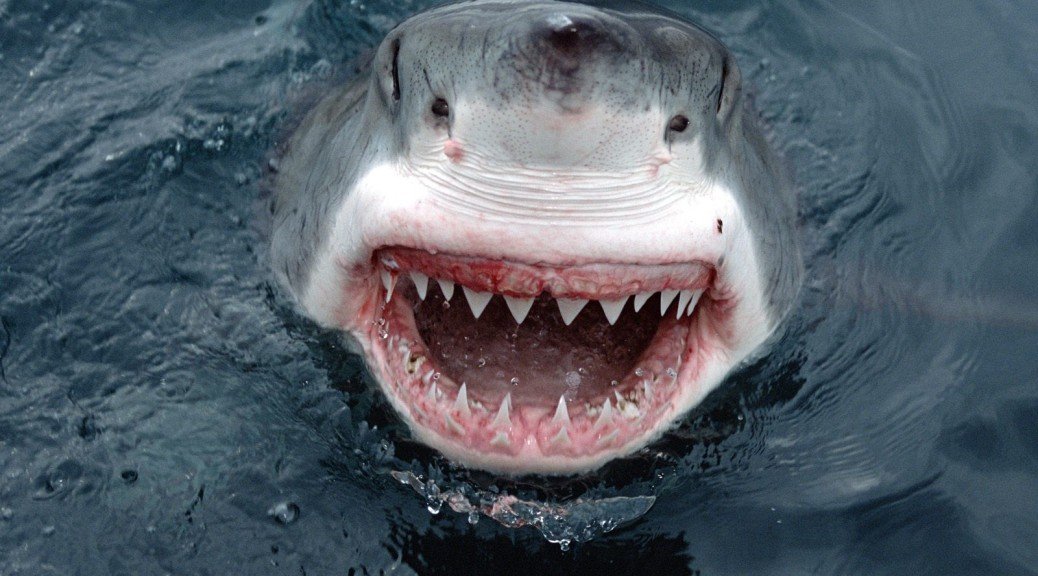NO CGI SHARKS AND STILL COMPELLING VIEWING: SHARK WEEK 2015: NIGHT ONE
SHARK WEEK 2015: Night One – Shark Trek, Island of the Mega Shark, and Monster Mako

Pros: Factual information and a large amount of amazing footage
Cons: Nature documentaries are “dry,” right?
Now in its 28th year of existence, Shark Week, Discovery Channel’s annual block of television shows devoted to the ocean’s most captivating predators, began on Sunday, July 5, 2015 with a trio of all-new documentaries that nicely picked up where previous year’s programming stopped. Truth be told, the last several years of Shark Week have gotten increasingly sketchy as faux-documentaries and “monster hunt” shows overwhelmed the actual science and biology that one would think this event was all about. I was particularly perturbed last year when Shark Week made nary a mention of the , which aimed to eliminate large man-eating sharks…by killing any shark, large or small, that a designated team of hunters came across. Thankfully, this year Discovery Channel seems to have realized that the sensationalized and/or straight phony programs and endless string of “I Was Attacked” recollections wasn’t do much to encourage shark conservation – a glance of the preliminary lineup for Shark Week 2015 shows a focus on –gasp!– actual facts and straight-faced documentaries.
Shark Week 2015 continues the hunt for bigger and badder sharks.
This certainly was the case with the opening day’s lineup which kicked off with Shark Trek. This hour-long program followed researcher Greg Skomal as he continued efforts to tag and study the behavior of the great white sharks off Cape Cod. In the time since last year’s Jaws Strikes Back, Skomal has increased the number of tagged animals to 56 and has begun to analyze the data being relayed by the tags. Some of the most important of this information relates to the migratory habits of the Atlantic white sharks – in the fall of 2014, several animals were tracked as they moved down the American East Coast to warmer regions in Florida – areas where beaches are substantially more popular than those in Massachusetts. Obviously, this brings the sharks in closer proximity to people, and Skomal’s main goal in the investigation here is to find out what drives the shark’s migration and determines where they wind up.
 Skoval attempting to tag a great white with his specially-rigged harpoon.
Skoval attempting to tag a great white with his specially-rigged harpoon.
The second of the opening night’s programs was Island of the Mega Shark, a semi-continuation of a pair of last year’s programs. This show found Dickie Chivell, who proved his insanity by riding a flimsy white shark decoy in last year’s frankly mind-blowing Air Jaws: Fin of Fury, joining forces with Lair of the Mega Shark’s Jeff Kurr and Andy Casagrande to again search for gigantic whites in the waters around Guadalupe Island, which lies off the coast of Baja, Mexico. This team attempts to solve some of the riddles relating to white shark reproduction, but one of the main points of this program is to again position Chivell as Shark Week’s resident daredevil. This time around, he finds himself in a so-called “ghost cage” whose four clear plastic sides are virtually invisible underwater – thus, he appears to be a free-swimming meal to any of the fourteen-to-sixteen-foot great whites in the area. Add in a malfunctioning door (literally, Chivell has to hold the cage shut) and you’ve got the formula for some crazy TV, but things get really wild when a heavily-pregnant, twenty-plus-foot shark appears on the scene.
Chivell in the “ghost cage.” Ya gotta give it to him: the man has cojones.
Finally, we had a program in Monster Mako that focused its attention on one of the lesser-known shark species, one which is rumored to reach speeds in excess of 30 MPH underwater and breech the surface in amazing fashion when stalking its prey. Despite a sensational title and a more dramatic approach (replete with a gruff-voiced narrator and moments of questionable tension), this program was actually fairly scientifically sound and quite interesting, as two groups of scientists attempted to document not only the speed of the mako sharks which inhabit the Gulf of Mexico, but also their ability to shoot missile-like from the ocean in pursuit of prey. The program eventually makes some interesting observations about the behavior and habits of these creatures, even though the majority of its running time plays as a sort of hunt which finds the two teams attempting to lure in specimens suitable for their research.
Monster Mako attempts to distinguish fact from fiction about this shark which, with its streamlined body and distinctive teeth, resembles a torpedo.
Clearly, one of the best things about this block of programming is that it avoided the types of frankly ridiculous mockumentaries of the Shark of Darkness variety. Everything included in Shark Week 2015’s opening day was based in actual fact and – surprise surprise – was far from boring. Sure, the average couch potato might grow tired of the “dry” documentaries featured here, but those honestly interested in sharks – arguably the crowd that Shark Week should be marketed towards in the first place – would eat them up. Even without the addition of giant CGI sharks, this opening night had its share of harrowing moments – particularly when Chivell had to literally push great whites out of his enclosed “ghost cage.” Additionally, there were even a few heartwarming “Aww!” moments provided by the appearance of a nine-year-old shark advocate who joined Skoval in his mission to tag various sharks. The hosts of these various programs are obviously enthusiastic about what they do, making the action they get involved in more compelling to watch.
 Now THAT looks like a big shark.
Now THAT looks like a big shark.
I’ve always found actual footage of sharks gliding through their marine environments to be stunningly beautiful, and the camerawork throughout these three programs was generally astounding. Especially cool were several sequences filmed near Guadalupe Island which showed the shallow coves where the native seal population attempts to hide from the lurking sharks – with their gently swaying and multicolored undersea plant life, these environments look otherworldly. Additionally, there were numerous aerial shots which showed both individual sharks and an enormous group of black tip sharks migrating off the Florida coast. Amazing as it is to see individual creatures breaking the surface, watching thousands of sharks just offshore around a populated area was jaw-dropping. It was also downright ominous to see huge sharks lurking just on the edge of visibility range in many of the underwater shots – particularly during the numerous dives featured in Island of the Mega Shark. The three shows featured here certainly emphasized the fact that groups of smaller sharks disappearing quickly signaled the arrival of a true monster, and these moments were captured perfectly through the actual camerawork and slick editing of the programs.
This. Looks. Dangerous.
On the downside, though both the Shark Cam (from last year’s Jaws Strikes Back) and the “Shark Eye” unit seen in Monster Mako attempted to provide underwater views of the sharks in action – sometimes from the perspective of the shark – neither of these devices really worked as well this time around and didn’t provide quite the unique perspective that one would have hoped for. I would have to say then that camera work through this opening trio of shows, while undeniably excellent (as I’d expect from Discovery Channel), was somewhat conventional and not as outwardly flashy as what I’ve seen in other, similar shows. Again, this didn’t really bother me – I’d rather have authentic representations and actual facts than a continual barrage of flashy visuals with sketchy information tacked alongside
Shark Cam – big hit of last year’s Shark Week, didn’t so much as get deployed this time around. Bummer.
Overall, Shark Trek, Island of the Mega Shark, and Monster Mako provided a wealth of solid information that would appeal to both the Shark Week veteran and newcomer. There was a nice amount of generalized information in these programs, as well as a chronicle of more individualized efforts to learn more about various shark species. The variety of topics covered here and fascinating overall presentation made for a strong opening night of Shark Week 2015. Since there’s no Megalodon in sight, I’m certainly looking forward to seeing what the rest of the week offers. This year’s edition of the Discovery Channel staple might not create intense water cooler discussion or ignite a social media firestorm, but I think it’s commendable that a more low-key approach with dedication to facts has been applied.
















